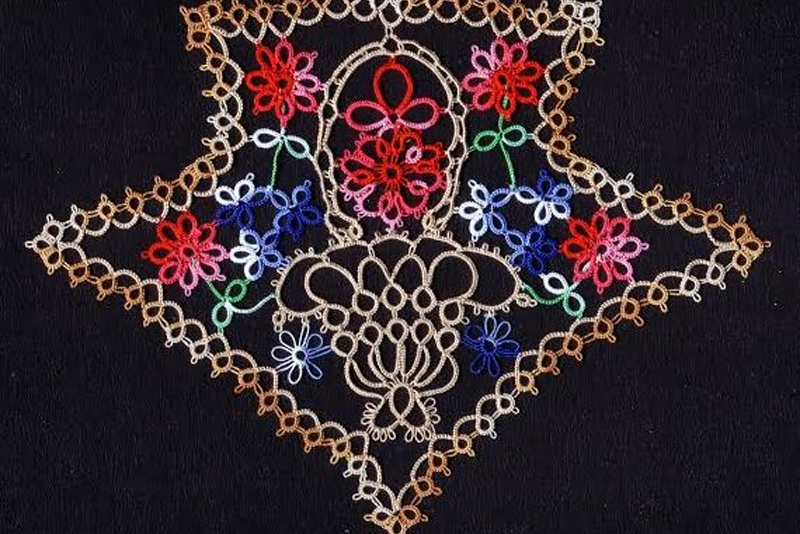Hello Tatters!
The exercise in writing a vintage pattern in modern tatting terms seems to have been welcomed by our readers. Martha Ess, a master tatter and designer (http://my.att.net/p/s/community.dll?ep=16&groupid=318278&ck=) was challenged by the incomplete write up of the 1857 edging and she has worked out the errors and prepared a sample for us:
http://www.georgiaseitz.com/bella/ess1857edging.jpg
Ch: 5 – 6 – 4 RW
*R: 3 + (to first made p of Ch) 6 – 3 clr RW (give Ch a twist to reach the picot); **Ch: 4 – 4 RW
R: 3 + (to prev R) 6 – 3 clr RW**; Ch: 4 – 4 RW
R: 3 + (to prev R) 6 – 3 clr RW ; Ch:4 – 4 RW
R: 3 + (to prev R) 7 – 2 clr
R: 2 + (to prev R) 7 – 2 clr RW; Ch: 3 RW
R: 3 + (to prev R) 8 – 3 clr RW; Ch: 3 RW
R: 2 + (to prev R) 7 – 2 clr
R: 2 + (to prev R) 7 – 3 clr RW; Ch: 4 + (to adj Ch) 4 RW
R: 3 + (to prev R) 3 – 3 – 3 clr RW; Ch: 4 + (to adj Ch) 4 RW
R: 3 + (to prev R) 3 – 3 – 3 clr RW; Ch: 4 + (to adj Ch)
R: 3 + (to prev R) 3 – 3 – 3 clr RW
Ch: 4 + (to adj Ch) 6 + (to last p of prev R) 10 – 6 – 4 RW
Repeat from * for length desired, but make first three rings as 3 + (to prev R) 3 + (to adj R) 3 – 3 clr. To make edging deeper, make extra repeats from ** to **, and add equal repeats on other side.
Bobbie Demmer, master tatter, historian and former tatting editor for the bulletion of the International Old Lacers, Inc., reports that the book "Flitting Fingers - Tatting in the Nineteenth Century", by Virginia Mescher has some wonderful comments about early tatting and how to interpret the directions.
"Flitting Fingers: Tatting in the 19th Century" by Virgina Mescher
Virgina Mescher is familiar to tatters from her article on Civil War Tatting which was enjoyed in the online tatting class in 2001. Her book is a real gem for tatters and tatting historians alike. Petite in size (8.5" x 5.5" or 21 x 14 cm), it is immense in the scope of information contained. It has 120 pages and contains an 8-page bibliography.
This fascinating look at tatting offers many 19th century instructions and patterns (similar to the Metternich Cravat by Mlle. Riego worked in class last year) from 1842 - 1889. Each pattern is fully documented with source and date. Many historical references to tatting and its origins are included.
The many types of tatting tools, needles, and shuttles are discussed and a list of tatting patents appears in the bibliography. See the Contents page. The section on the mechanics of tatting as presented in antique publications is equally as intriguing as the discussion of the "English" and the "French" stitches! Long needed, this book fills a niche in the history of tatting. It is a great read and should be in every library! (Mini book review by Georgia Seitz NB: all books mentioned are part of my personal tatting reference library acquired over the last 3 decades.)
For more history please visit:
http://www.bellaonline.com/subjects/3138.asp
For more patterns using the half-closed ring please visit the website of Mark Myers, aka Tatman: http://www.tat-man.net/tatterville/tatpatterns/motifs.html
Here's the latest article from the Tatting site at BellaOnline.com.
Building a Tatting Library - Ineke Kuiperij
Ineke Kuiperij is a name to remember. A master tatter from the Netherlands, she has created a wonderful world of 3-dimensional tatting. Her tatted Carousel is a wonder to behold!
http://www.bellaonline.com/articles/art51432.asp
Please visit tatting.bellaonline.com for even more great content about Tatting.
To participate in free, fun online discussions, this site has a community forum all about Tatting located here -
http://forums.bellaonline.com/ubbthreads.php?ubb=postlist&Board=39
I hope to hear from you sometime soon, either in the forum or in response to this email message. I thrive on your feedback!
Have fun passing this message along to family and friends, because we all love free knowledge!
Georgia Seitz, Tatting Editor
http://tatting.bellaonline.com
One of hundreds of sites at BellaOnline.com
tatting Newsletter







